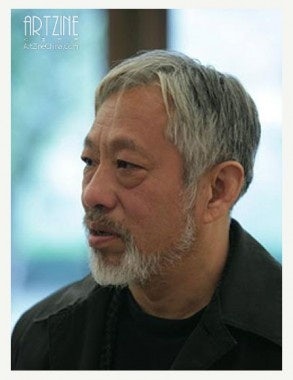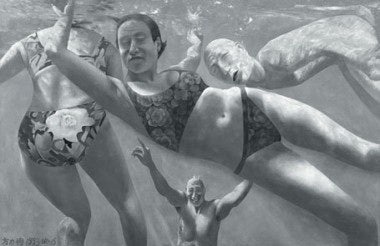"Godfather Of Chinese Contemporary Art" Advocates More Chinese Art Collection To Ensure Works Can Be Seen Domestically#

At recent events like the Global Collecting Forum and the Songzhuang Art Festival's Conference of Collectors of Chinese Contemporary Art, a major topic of discussion among Chinese scholars and art critics has been the need for Chinese collectors of contemporary art (and Chinese museums and galleries) to acquire more top-quality pieces while educating the public on the history, subject matter, figures and current state of Chinese contemporary art.
At the Songzhuang Festival, Chinese art critic Li Xianting -- who has been called the "Godfather of Chinese Contemporary Art" -- gave a speech in which he said collecting Chinese contemporary art is a form of "cultural creation" which requires the urgent attention of Chinese collectors. Since the breakout of Chinese contemporary art in the late 1970s and its development over the years, the majority of major works of art have been acquired by Western collectors, and although that is changing gradually as Chinese buyers amass their own collections, Li still sees disequilibrium in the global marketplace. By building collections of Chinese contemporary art now, and continuing to patronize Chinese artists in the same way the Medici family did in Renaissance-era Italy, Li feels that Chinese art can reach the Chinese people themselves by building a new form of aesthetic education while stemming the flow of artwork out of the country.
Artxun (Chinese) posted the entirety of Li's speech today. Translation of excerpts by Jing Daily team:
Collection is a kind of cultural creation, and in collecting contemporary art one must face value standards, but value standards in a progressing era are of a very uncertain ideological form, and collectors -- through their behavior -- have to confirm whether they're actually qualified to become the builders of value standards in the era in which we live. Every major collector who made an important contribution to art history, such as the Renaissance-era Medici family or the Guggenheims, Ludwig II...the famous American and Italian Guggenheim museums, and Germany's Ludwig Museum -- named after these collectors -- because of these people and places collecting artwork, some of these works of art have become critical elements of art history.
Value standards are like the core of a culture, the artistic values of the system. In humanities and arts that show a distinct and unique profile we can say an era's culture can be considered basically mature. Song, Yuan, Ming, and Qing Dynasty scholarly culture, from their conceptions of elegance to their enjoyment of pen and ink, had complete sets of values. In the wake of last century's "May Fourth Movement" (ed. note: 1919 student-led demonstrations held in Beijing to protest imperialism and the Chinese government's weak response to the Treaty of Versailles), when the banner of national salvation and strengthening the country was held high, led by the teachings of Western Realism, the tradition of subversive art -- particularly after 1949 -- in the context of the Cold War, China re-isolated itself from the West, and within the socialist family, Mao Zedong and the Soviet models combined the line of unity and struggle, and the Maoist model -- under the direct guidance of Mao Zedong, by way of Soviet socialist realism -- adapted Chinese folk aesthetics into the revolutionary realist style.
Since the late 1970s, China once again opened itself to the world, and the Maoist style has been subverted, but more than 30 years of artistic practice has yet to clearly outline Chinese art, or at least we still haven't reached a consensus on it. The way I see it, there are three main clues to why that I think are quite clear: First, from the late 1970s to the mid-1990s, we have China's modern era and contemporary art movement. Three decades, during which artists experimented with every Western art movement and school of thought in contemporary art. In general, the use of Western modern art in China as a source of reference has these approximate ranges: 1979-1984, Impressionism to Abstract Expressionism; 1985-1989, Dada, Surrealism, as well as Joseph Beuys and so forth; to the late 1980s and early 1990s, Pop art. Chinese art since the opening in the late 1970s all takes place in the context of globalization, not in the sense of opening up to the background, nor does it refer to other countries' contemporary art in the same space of exchange, more like learning the last 100 years of Western modern art history. However, China's imitation of modern Western art and drawing merely comes from the language level, and Chinese contemporary artists expressing their feelings about their existence are always closely related to China's cultural, political and social development.
Second, Realism...I haven't done an in-depth study on this, but the difference lies in a single word; I want to plant the seeds of change. I want to say that realism can be contemporary art, regardless of the meaning of the word...In the late 1980s and early 1990s, Fang Lijun, Liu Xiaodong, Liu Wei, Song Yonghong and other artists experienced a lack of belief in society as a whole and emotional confusion, and put their everyday lives, boredom and nausea into their art, creating a new mode of realism.
Fang Lijun
...
To say that art collection is a kind of cultural creation has another meaning; it refers to the art and the community -- the relationship between the public and artistic education. When we go to any country's art museums to see artwork, we practically always see packs of students from kindergarten up through middle school who've been taken there to enjoy ancient and modern masterpieces. Art appreciation is a lifelong form of education, from childhood onward, for people in modern wealthy societies, and in every kind of art gallery and museum system -- as the social environment for mass education in a modern civilization -- it practically always accompanies every person's maturing experience. But, unfortunately, China does not have such a social environment...In China, there's no real sense of art museums. The role of the national and local government museums is, at best, just to function as an exhibition space -- to mixed success -- let alone to serve the function of aesthetic education.
We can't expect the government to establish, from top to bottom, an art museum system in such a short amount of time, not least because the construction of the "hardware" is so difficult, but what's harder is [assembling] the artwork itself, because up until now the collection in the government's museum of contemporary art has been really poor, and not only because in the past three decades the important works of Chinese contemporary art have flowed overseas. Can the government spend the money to collect contemporary art? Aside from lack of funds, the hardest thing is that within a considerable amount of time, could the government possibly recognize the value of a contemporary art value system?
...
Fortunately, in recent years collection of contemporary art by Chinese collectors has entered the agenda, so building the optimal relationship between Chinese contemporary art's value standards and art collection is already imminent. Especially after experiencing the changes in the global art market following the shock of the global economic crisis, we deeply felt that we had a huge historical responsibility. We hope that through joint effort, through private collectors helping to keep important works of contemporary art inside the country and also through private channels, we can accomplish the gradual completion of cultural construction -- that is to say, aside from the National Museum of Contemporary Art system's matters -- through private collections and the opening up of new channels, through the many diverse small galleries popping up everywhere taking the lead in building a connection between contemporary art and society, an artistic bridge between contemporary art and the general public. Through all of this, we hope they can set the stage for a Chinese style of modern aesthetic education and cultural development.

Third, Chinese ink painting since the mid-1980s, as represented by the new scholarly paintings which abandoned notions of realist ink paintings from 1910 to the 1970s, bringing back the ancient Chinese scholarly painting traditions that had been looking for nourishment. At the same time, some brush and ink artists have absorbed aspects of Western modern art, to develop a modern style of ink painting.